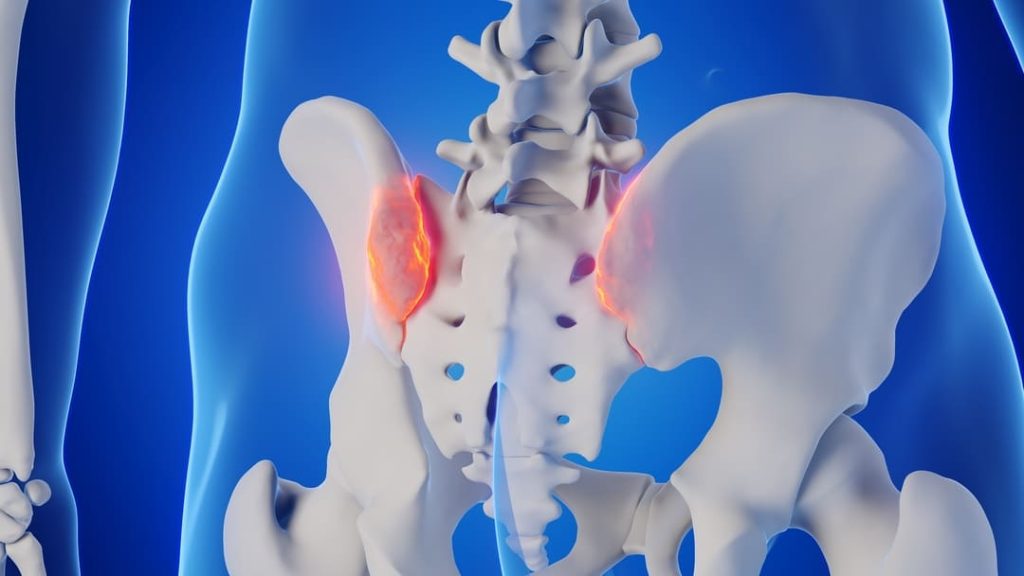Looking for Expert-Level VA Claim Answers?📱Call Us Now! 737-295-2226
Do you struggle with chronic lower back or hip pain that makes daily life harder? You may have sacroiliitis, and if your condition stems from military service, you could qualify for VA disability compensation.
Sacroiliitis often shows up as persistent inflammation in the sacroiliac joints, and it’s more than just back pain; it can limit your range of motion, disrupt your sleep, and interfere with your ability to work.
In this guide, we’ll explain how the VA rates sacroiliitis, how to file a strong claim, and what you need to get the benefits you deserve.
Table of Contents
Summary of Key Points
- The VA rates sacroiliitis under the general formula for spine conditions, using Diagnostic Codes 5235–5243.
- Ratings range from 10% to 100%, depending on severity, range of motion loss, and symptom impact.
- Veterans must prove a current diagnosis, an in-service event, and a nexus between the two.
- You may still qualify for TDIU if sacroiliitis prevents you from working, even if your rating is below 100%.
What is Sacroiliitis?

Sacroiliitis is a painful condition affecting one or both sacroiliac joints, which sit where your lower spine and pelvis meet.
Generally, these joints act as shock absorbers, helping decrease stress on your pelvis and spine. However, if one or more of these joints becomes inflamed, you’ll likely experience discomfort and mobility issues.
Speaking with a medical professional about your condition is vital because sacroiliitis can lead to permanent joint damage if left untreated.
Symptoms
- Lower back pain
- Stiffness
- Hip pain
- Limited range of motion
- Fatigue
- Fever
Sacroiliitis VA Disability Ratings
The VA rates sacroiliitis at 10%, 20%, 30%, 40%, 50%, and 100% under diagnostic codes 5235 through 5243 of 38 CFR § 4.71a, General Rating Formula for Diseases and Injuries of the Spine.
Your sacroiliitis VA disability rating will depend on the severity, frequency, and duration of symptoms, including Limitation of Range of Motion (ROM) and Painful Motion.
How to Prove Service Connection
Veterans suffering from sacroiliitis because of their military service should know how to prove a service connection and file a VA disability claim.
To receive a sacroiliitis VA disability rating, you must meet the following requirements:
- A current medical diagnosis of sacroiliitis
- An in-service event, injury, illness, or aggravation
- A medical nexus (or link) between the current diagnosis and the in-service event, injury, or illness (can be a Nexus Letter)
5 Steps to Filing a VA Claim
To file a VA claim to receive a VA rating for sacroiliitis, use the following five steps:
- Gather Documentation: Collect medical records showing current diagnosis, test results, service records, and other evidence, such as Medical Nexus Letter or Independent Medical Opinion (IMO) linking your sacroiliitis to your military service.
- Complete VA Form 21-526EZ: Fill out this form to apply for disability compensation. Include details about your exposure, symptoms, and how it affects your daily life.
- Submit Your Claim: Send the completed form and supporting documents to the VA regional office handling your claim. You can submit it online through the VA website, by mail, or in person.
- Undergo Examinations: The VA might schedule you for a C&P examination to evaluate the extent of your sacroiliitis.
- Await the Decision: The VA will review your claim, considering the evidence provided.
The VA will notify you of their decision regarding your eligibility for a sacroiliitis VA disability rating, including VA benefits and compensation.
C&P Exam for Sacroiliitis
Sacroiliitis is difficult to diagnose because it’s often mistaken for other lower back conditions, so you’ll likely be required to attend a compensation and pension (C&P) exam.
Your C&P exam is the opportunity to show the VA how your condition affects your life. While honesty is important, you don’t want to exaggerate or lie about your condition.
This is the #1 VA C&P Exam Tip (Video)
VA Back Ratings
You’ll be assigned an appropriate diagnostic code depending on your specific diagnosis.
Here’s an overview of some of the diagnostic codes (DC) regarding back ratings.
- DC 5235 – Vertebral fracture or dislocation: The bones of the spine break or slip out of alignment due to a traumatic event like a car accident. Any generic spinal bone injury would be coded here.
- DC 5236 – Sacroiliac injury and weakness: Pain in the joints connecting the pelvis and lower spine.
- DC 5237 – Lumbosacral or cervical strain: A generic label for back pain.
- DC 5238 – Spinal stenosis VA disability rating: The spinal column narrows and presses on the spinal cord or nerves.
- DC 5239 – Spondylolisthesis or segmental instability: When a vertebra slips out of position.
- DC 5240 – Ankylosing spondylitis: An arthritic disease that causes the spinal joints to freeze in place.
- DC 5241 – Spinal fusion: The vertebrae are surgically fused together.
- DC 5242 – Degenerative arthritis, degenerative disc disease: a condition in which pain is caused by a disc that wears down.
- DC 5243 — Intervertebral disc syndrome: a common condition characterized by the breakdown (degeneration) of one or more of the discs that separate the bones of the spine (vertebrae), causing pain in the back or neck and frequently in the legs and arms.
General VA Rating Chart for Back Pain
| General Rating Formula for Diseases and Injuries of the Spine | VA Rating |
| For diagnostic codes 5235 to 5243, unless 5243 is evaluated under the Formula for Rating Intervertebral Disc Syndrome Based on Incapacitating Episodes | |
| With or without symptoms such as pain (whether or not it radiates), stiffness, or aching in the area of the spine affected by residuals of injury or disease | |
| Unfavorable ankylosis of the entire spine | 100% |
| Unfavorable ankylosis of the entire thoracolumbar spine | 50% |
| Unfavorable ankylosis of the entire cervical spine; or, forward flexion of the thoracolumbar spine 30 degrees or less; or, favorable ankylosis of the entire thoracolumbar spine | 40% |
| Forward flexion of the cervical spine 15 degrees or less; or, favorable ankylosis of the entire cervical spine | 30% |
| Forward flexion of the thoracolumbar spine greater than 30 degrees but not greater than 60 degrees; or, forward flexion of the cervical spine greater than 15 degrees but not greater than 30 degrees; or, the combined range of motion of the thoracolumbar spine not greater than 120 degrees; or, the combined range of motion of the cervical spine not greater than 170 degrees; or, muscle spasm or guarding severe enough to result in an abnormal gait or abnormal spinal contour such as scoliosis, reversed lordosis, or abnormal kyphosis | 20% |
| Forward flexion of the thoracolumbar spine greater than 60 degrees but not greater than 85 degrees; or, forward flexion of the cervical spine greater than 30 degrees but not greater than 40 degrees; or, combined range of motion of the thoracolumbar spine greater than 120 degrees but not greater than 235 degrees; or, combined range of motion of the cervical spine greater than 170 degrees but not greater than 335 degrees; or, muscle spasm, guarding, or localized tenderness not resulting in abnormal gait or abnormal spinal contour; or, vertebral body fracture with loss of 50 percent or more of the height | 10% |
If you don’t qualify for the range of motion listed above, you may qualify for a back pain VA rating if you have intervertebral disc syndrome, found under diagnostic code 5243
| Formula for Rating Intervertebral Disc Syndrome Based on Incapacitating Episodes | VA Rating |
| With incapacitating episodes having a total duration of at least 6 weeks during the past 12 months | 60% |
| With incapacitating episodes having a total duration of at least 4 weeks but less than 6 weeks during the past 12 months | 40% |
| With incapacitating episodes having a total duration of at least 2 weeks but less than 4 weeks during the past 12 months | 20% |
| With incapacitating episodes having a total duration of at least one week but less than 2 weeks during the past 12 months | 10% |

Sacroiliitis and TDIU
If you receive a sacroiliitis VA disability rating of less than 100%, you may still qualify for the maximum VA rating if your condition prevents you from maintaining substantially gainful employment.
If you qualify for total disability based on individual employability, you’ll receive a rate equivalent to a 100% VA disability rating.
Conclusion
Living with sacroiliitis can mean more than just physical pain—it can affect your work, relationships, and overall quality of life. If your condition is linked to your military service, you deserve the right support.
Understanding how the VA rates sacroiliitis and how to file a strong claim is the first step toward getting the benefits you’ve earned.
Want Expert-Level Support for Your VA Disability Claim? WE GOT YOUR SIX!
- VA Claims Insider is the #1 most trusted name in VA disability claims.
- Work directly with a VA claims coach who can educate you to VA claim victory.
- 25,000+ disabled veterans have served in our membership programs since 2016.
- 30% average rating increase for veterans who complete our #1-rated Elite program.
- 4.7/5.0 average rating out of 5,500+ total reviews; over 4,500 5-star reviews.
FAQs | Frequently Asked Questions
What is the VA disability rating for sacroiliac joint dysfunction?
The VA rates sacroiliac joint dysfunction at 10%, 20%, 30%, 40%, 50%, and 100%, depending on the severity, frequency, and duration of your symptoms.
What is the maximum sacroiliitis VA disability rating?
The maximum sacroiliitis VA rating is 100%.
What medical evidence is required for a VA disability claim for sacroiliitis?
To help you get the highest possible sacroiliitis VA rating, you should include strong medical evidence with your claim. This includes medical records confirming your current diagnosis of sacroiliitis, a Nexus Letter linking your condition to your military service, and any independent medical opinions (IMOs) that support your case. Diagnostic test results that document the severity of your symptoms can also be helpful. In some cases, buddy statements from fellow service members or family can provide additional context, though they are optional.
Can sacroiliitis be rated as a secondary condition?
Yes, sacroiliitis can be rated as a secondary service-connected condition if it’s caused or worsened by another service-connected disability, such as spinal injuries, arthritis, or even leg length discrepancies.
Does sacroiliitis qualify for a bilateral factor rating?
Potentially. If both sacroiliac joints are affected and cause functional limitations in both legs, the VA may apply the bilateral factor to increase your combined disability rating.
Author

Kelly Olone
Kelly Olone is a military spouse who earned her degree in Psychology from Florida International University. After working in the non-profit sector for several years, she turned to her passion for writing. She aims to contribute to a better understanding of the valuable benefits that veterans deserve. As a mom, Kelly navigates the delicate balance between deadlines and bedtime stories with finesse.



